
The National Association for the Advancement of Colored People
(NAACP) and its legal offspring, the Legal Defense and Educational
Fund, developed a systematic attack against the doctrine of "separate
but equal." The campaign started at the graduate and professional
educational levels. The attack culminated in five separate cases
gathered together under the name of one of them--Oliver Brown
v. Board of Education of Topeka, Kansas.
Aware of the gravity of the issue and concerned with the possible
political and social repercussions, the U.S. Supreme Court heard
the case argued on three separate occasions in as many years. The
Court weighed carefully considerations involving adherence to legal
precedent, social-science findings on the negative effects of segregation,
and the marked inferiority of the schools that African Americans
were forced to attend.
The Supreme Court announced its unanimous decision on May 17,
1954. It held that school segregation violated the Equal Protection
and Due Process clauses of the Fourteenth Amendment. The following
year the Court ordered desegregation "with all deliberate speed."
The Library of Congress
does not have permission to show this image online.
Notebook recording data concerning the Doll
Test, 1940-1941. Kenneth B. Clark Papers,
Manuscript Division (61) |
Kenneth B. Clark's "Doll Test" Notebook
During the 1940s, psychologists Kenneth
Bancroft Clark and his wife, Mamie Phipps Clark designed
a test to study the psychological effects of segregation
on black children. In 1950 Kenneth Clark wrote a paper for
the White House Mid-Century Conference on Children and Youth
summarizing this research and related work that attracted
the attention
of Robert Carter of the NAACP Legal Defense Fund. Carter
believed that Clark's findings could be effectively used
in court to show that segregation damaged the personality
development of black children. On Carter's recommendation,
the NAACP Legal Defense Fund engaged Clark to provide expert
social science testimony in the Briggs, Davis,
and Delaware cases. Clark also co-authored a summation of
the social science testimony delivered during the trials
that was endorsed by thirty-five leading social scientists.
The Supreme Court specifically cited Clark's 1950 paper in
the Brown decision.

|
Dr. Kenneth Clark Conducting the "Doll Test"
In the "doll test," psychologists Kenneth
and Mamie Clark used four plastic, diaper-clad dolls, identical
except for color. They showed the dolls to black children
between the ages of three and seven and asked them questions
to determine racial perception and preference. Almost all
of the children readily identified the race of the dolls.
However, when asked which they preferred, the majority selected
the white doll and attributed positive characteristics to
it. The Clarks also gave the children outline drawings of
a boy and girl and asked them to color the figures the same
color as themselves. Many of the children with dark complexions
colored the figures with a white or yellow crayon. The Clarks
concluded that "prejudice, discrimination, and segregation" caused
black children to develop a sense of inferiority and self-hatred.
This photograph was taken by Gordon Parks for a 1947 issue
of Ebony magazine.
|
The Library of Congress
does not have permission to show this image online.
Gordon Parks, photographer. Dr. Kenneth
Clark conducting the "Doll Test" with a young male child,
1947.
Gelatin silver print.
Prints and Photographs Division (62) |
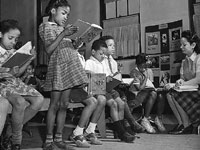
Marjory Collins.
Reading lesson in African American elementary
school in Washington, D.C., 1942.
Gelatin silver print.
FSA-OWI Photograph Collection,
Prints and Photographs Division (57C)
|
Reading Lesson in Washington, D.C.
As the nation's capital became more and
more populated by blacks in the first half of the twentieth
century, the schools in District of Columbia became more
segregated. During World War II, there was no new construction
of schools and the few that existed were extremely overcrowded.
After the war, new construction started but did not meet
the needs of the District's populace. Many black students
were attending schools in shifts while many of the white
schools sat nearly empty. This condition eventually led to
the Bolling v. Sharpe case, one of the five included
in the Brown v. Board of Education decision. |
Kenneth B. Clark's "Doll Test" Data Sheet
The Clarks used printed data sheets to
record the children's responses during the "doll test," as
well as general observations. This data sheet lists the nine
questions that were routinely asked. The letters "B" and "W" denote "black" and "white." The
abbreviations "LB" and "DB" denote "light brown" and "dark
brown" complexions. The data reveals that Mark A., a black
boy age four with a dark brown complexion, prefers the white
doll and selects the white doll as the one that looks like
him.
|
The Library of Congress
does not have permission to show this image online.
Sample Doll Test data sheet, n.d. Kenneth
B. Clark Papers,
Manuscript Division (64) |
The Library of Congress
does not have permission to show this image online.
Testimony of Expert Witnesses at Trial
of Clarendon County School Case Direct Examination by Robert
L. Carter, May 29, 1951. Transcript.
NAACP Records,
Manuscript Division (57) |
Briggs v. Elliott (South Carolina)
In 1949, the state NAACP in South Carolina
sought twenty local residents in Clarendon County to sign
a petition for equal education. The petition turned into
a lawsuit and first name on the list was Harry Briggs. In
preparation for the Briggs case, attorney Robert
Carter returned to Columbia University to confer with Psychologist
Otto Klineberg, who was known for his research on black students'
IQ scores. He sought Klineberg's advice on the use of social
science testimony in the pending trial to show the psychological
damage segregation caused in black children. Klineberg recommended
Kenneth Clark. Clark became the Legal Defense Fund's principal
expert witness. He also agreed to assist the Legal Defense
Fund 's lawyers in the preparation of briefs and recruit
other prominent social scientists to testify. This document
records the depositions of two expert witnesses who participated
in Briggs v. Elliott: David Krech, a social
psychology professor at the University of California; and
Helen Trager, a lecturer at Vassar College. |
Bolling v. Sharpe, (Washington D.C.)
Spottswood Thomas Bolling v. C. Melvin
Sharpe, was one of the five school desegregation cases
that comprised Brown. Because the District of
Columbia was not a state but federal territory, the Fourteenth
Amendment arguments used in the other cases did not apply.
Therefore, the lawyers argued for "Due Process Clause" of
the Fifth Amendment, which guaranteed equal protection
of the law. The Consolidated Parents Group initiated a
boycott of the black High School in Washington. D.C., which
was overcrowded and dilapidated. In 1948, Charles H. Houston
was hired to represent them in a law suit to make black
schools more equal to white schools when Houston's health
began to fail. He recommended James Nabrit as his replacement.
Nabrit was joined by fellow attorney, George E. C. Hayes
in presenting arguments for the District of Columbia case.

|
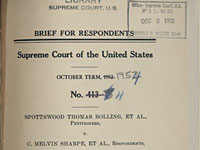
U. S. Supreme Court Records
and Briefs, 1954 Term.
Supreme Court Records and Briefs,
Law Library (57B)
|
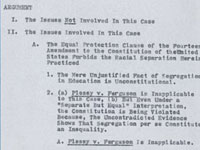
Brief of the Attorneys
for the Plaintiffs (Charles
E. Bledsoe, Charles Scott, Robert L. Carter, Jack Greenberg,
and Thurgood Marshall) in the case of Oliver Brown,
. . .delivered in the United States Court for the District
of Kansas,
June 1951.
Page 2
NAACP Records,
Manuscript Division (54)
Courtesy of the NAACP
|
Brief of the Attorneys for the Plaintiffs in Brown
In June 1950, shortly after the Sweatt, McLaurin,
and Henderson victories, Thurgood Marshall convened
a conference of the NAACP's board of directors and affiliated
attorneys to determine the next step in the legal campaign.
After several days of debate, Marshall decided to shift the
focus from the inequality of separate black schools to a
full assault on segregation. The NAACP immediately instituted
lawsuits concerning segregated public schools in Southern
and border states. Brown v. Board of Education was
filed in the U.S. District Court in Topeka, Kansas, in February
1951 and litigated concurrently with Briggs v. Elliot in
South Carolina. Oliver Brown, one of thirteen plaintiffs,
had agreed to participate on behalf of his seven-year-old
daughter Linda, who had to walk six blocks to board a school
bus that drove her to the all-black Monroe School a mile
away. |
Finding of Fact for the Case of Oliver Brown
On June 25, 1951, Robert Carter and Jack
Greenberg argued the Brown case before a three judge
panel in district court in Kansas. They were assisted by
local NAACP attorneys Charles Bledsoe and brothers John and
Charles Scott. As in Briggs, the testimony of social
scientists was central to the case. The Court found "no willful,
intentional or substantial discrimination" in Topeka's schools.
However, presiding Judge Walter A. Huxman appended nine "Findings
of Fact" to the opinion. Fact VIII endorsed the psychological
premise that segregation had a detrimental effect on black
children. This was the windfall the NAACP needed to appeal
the case to the Supreme Court. Briggs and Brown were
the first cases to reach the Court; three others followed.
The Court decided to bundle all five cases and scheduled
a hearing for December 9, 1952.

|
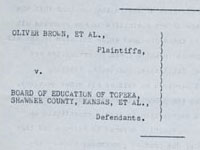
Opinion and Finding of
Fact for the case of Oliver Brown, et al. v. Board of
Education Topeka, Shawnee County, Kansas, et al. Delivered
in the United States Court for the District of Kansas,
1951.
NAACP Records,
Manuscript Division (55)
Courtesy of the NAACP
|
The Library of Congress
does not have permission to show this image online
Trial Memorandum from Jack Greenberg concerning
the Wilmington school case, October 11, 1951.
NAACP Records,
Manuscript Division (58) |
Gebhart v. Belton; Gebhart v. Bulah (Delaware)
In 1950 Louis Redding filed a lawsuit
on behalf of Sarah Bulah to admit her daughter Shirley to
a nearby white elementary school, after the Delaware Board
of Education refused to allow her to board an all-white school
bus that drove pass their home. In 1951, Redding filed a
second suit on behalf of Ethel Belton and nine other plaintiffs,
whose children were barred from attending the all-white high
school in their community. That fall, Thurgood Marshall sent
Jack Greenberg to Wilmington to work with Redding on the
litigation. Greenberg drafted this meticulous trial memorandum
the week before the hearing. In it he provides a schedule
of witnesses, instructions on deposing the witnesses, and
the questions to be posed. Among the witnesses listed are
psychologists Kenneth Clark and Otto Klineberg. |
A Court Rules: Equalization, Not Integration
Spurred by a student strike, blacks in
Prince Edward County, Virginia, called a lower federal court's
attention to the demonstrably unequal facilities in the county's
segregated high schools. As this "Final Decree" in Davis
v. County School Board shows, they convinced the U.S.
District Court that facilities for blacks were "not substantially
equal" to those for whites. The Court ordered the two systems
to be made equal. However, it did not abolish segregation.
Therefore, the plaintiffs appealed, and the Supreme Court
heard their case along with Brown v. Board. |
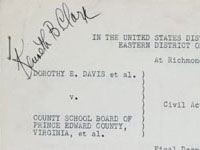
United States District Court
for the Eastern District of Virginia. Final Decree,
[1952].
Typed memorandum.
Kenneth Clark Papers,
Manuscript Division (59)
|
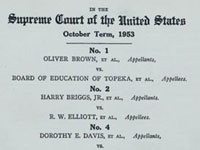
Brief for Appellants in
the cases of Brown v. Board of Education: Oliver Brown,
et al. v. Board of Education, Kansas et al.; . . . in
the United States Supreme Court-October Term, 1953.
Washington: GPO, 1953.
Pamphlet.
NAACP Records,
Manuscript Division (73)
Courtesy of the NAACP
|
Brief for Appellants, Brown v. Board, 1953
The Supreme Court did not render a judgement
after the initial oral arguments in Brown v.
Board. Instead, the Court submitted a list of five questions
for counsel to discuss at a rehearing that convened on December
7, 1953. The questions pertained to the history of the Fourteenth
Amendment and the relation between the views of the Amendment
framers' intent to "abolish segregation in public schools." The
questions also addressed what remedies to be used in the
event the Court ruled segregation in public schools unconstitutional.
After assessing the questions, the NAACP Legal Defense Fund
assembled a team of experts, including John A. Davis, a professor
of political science at Lincoln University, Mabel Smythe,
an economist, and psychologist Kenneth Clark, and scholars
John Hope Franklin, C. Vann Woodward, and Horace Mann Bond,
to conduct research during the summer. |
Eisenhower and Davis
As President (1953-1961), Dwight David
Eisenhower took decisive action to enforce court rulings
eliminating racial segregation. He would not, however, endorse
the Brown decision or condemn segregation as morally
wrong. John W. Davis, who had been the Democratic Party's
unsuccessful candidate for president in 1924, was the lead
counsel in the South's effort to uphold the Plessy v.
Ferguson doctrine of "separate but equal" in arguments
before the Supreme Court in 1953. The two men are shown meeting
in New York in October 1952, shortly before Davis would endorse
Eisenhower for president. Thurgood Marshall in later years
would say of Davis, "He was a good man . . . who believed
segregation was a good thing."
|
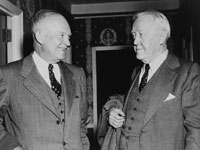
Ike with John W. Davis
at the Herald Trib Forum 10/21, 1952.
Photograph.
New York World-Telegram & Sun Collection,
Prints and Photographs Division (73A)
|
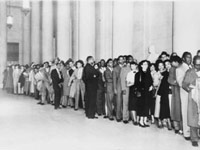
Waiting for courtroom seats,
1953.
Gelatin silver print.
New York World-Telegram & Sun Collection,
Prints and Photographs Division (74)
Digital ID# cph 3c13498
|
Waiting for Courtroom Seats
This photograph shows interested members
of the public waiting in line outside the Supreme Court for
a chance to obtain one of the 50 seats allotted to hear the
second round of arguments in the landmark Brown v. Board
of Education case. The case involved four states (Kansas,
Virginia, Delaware and South Carolina) and the District of
Columbia. Among an impressive array of legal representation
for the plaintiffs was Thurgood Marshall serving as chief
council for the NAACP. The opposing side was led by John
W. Davis, one time Democratic presidential candidate and
expert on constitutional law. |
Three Lawyers Confer at the Supreme Court
In preparation for the Brown court
case the three lead lawyers gathered to discuss their final
strategy. Pictured (left to right)are Harold
P. Boulware, (Briggs case), Thurgood Marshall, (Briggs case),
and Spottswood W. Robinson III (Davis case). The
lawyers said that the Brown case hoped to end the "separate
but equal" doctrine of the earlier Plessy decision
and make it illegal to continue segregation in public schools. |
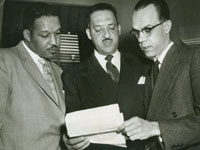
Three lawyers confer at the
Supreme Court, 1953.
Gelatin silver print.
New York World-Telegram & Sun Collection,
Prints and Photographs Division (98)
|
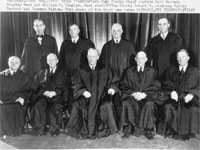
U. S. Supreme Court Justices,
1953.
Photograph.
New York World-Telegram & Sun Collection,
Prints and Photographs Division (102)
|
The Warren Court
Pictured in this photograph are nine
members of the Supreme Court that decided Brown v. Board
of Education. Seated in the front row (from left)
Felix Frankfurter, Hugo Black, Earl Warren, Stanley Reed,
and William O. Douglas. In the back row are Tom Clark, Robert
H. Jackson, Harold Burton, Sherman Minton. The photograph
was taken late in 1953, after President Dwight D. Eisenhower
had nominated Warren to the Court, but before the U.S. Senate
had confirmed him as Chief Justice. |
Brown Attorneys After the Decision
Three lawyers, Thurgood Marshall (center),
chief counsel for the NAACP's Legal Defense Fund and lead
attorney on the Briggs case, with George E. C. Hayes
(left) and James M. Nabrit (right), attorneys
for Bolling case, standing on the steps of the Supreme
Court congratulating each other after the court ruling that
segregation was unconstitutional. |
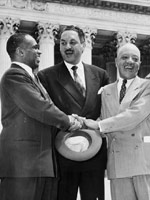
George E. C. Hayes, Thurgood
Marshall, and James M. Nabrit congratulating each other,
1954.
Gelatin silver print.
New York World-Telegram & Sun Collection,
Prints and Photographs Division (99)
[Dig ID # cph 3c11236]
|
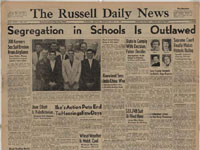
The Russell
Daily News (Russell, Kansas),
Monday, May 17, 1954.
Enlarged version
Historic Events Newspaper Collection,
Serial and Government Publications Division (84)
|
"Segregation in Schools is Outlawed"
The case that gave the Brown v. Board
of Education decision its name originated in a Federal
District Court in Topeka, Kansas. The Russell Daily
News, serving the city and county of Russell, Kansas,
announced the decision with a banner headline and two front
page stories. On the day of the decision, this evening
newspaper carried United Press reports from Washington,
D.C., and from Topeka, along with the ruling and the Kansas
Attorney General's statement of intention to comply. |
Humiliation and Inferiority
William T. Coleman assisted Thurgood
Marshall with the planning and execution of the Brown litigation.
Member of the NAACP Legal Committee, Coleman's stellar academic
record at the University of Pennsylvania and Harvard Law
School paved his way to the Supreme Court, where he became
the first African American clerk in 1948. Coleman wrote this
memorandum for Associate Justice Felix Frankfurter in 1949.
Agreeing with Coleman's contention that segregation was unconstitutional
because it was an humiliating sign of inferiority, Frankfurter
commented: "That it is such has been candidly acknowledged
by numerous accounts & adjudications in those States
where segregation is enforced. Only self conscious superiority
or inability to slip into the other fellow's skin can fail
to appreciate that." |
The Library of Congress
does not have permission to show this image online.
William Coleman to Felix Frankfurter, August
5, 1949.
Typed memorandum with handwritten notes.
Felix Frankfurter Papers,
Manuscript Division (48) |
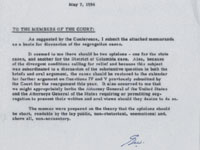
Earl Warren to members of
the Court, May 7, 1954.
Typed memorandum.
Earl Warren Papers,
Manuscript Division (80)
|
Warren Works For Unanimity
Realizing that overturning school segregation
in the South might entail a degree of social upheaval, Chief
Justice Warren carefully engineered a unanimous vote, one
without dissents or separate concurring opinions. Assigning
the two opinions--one for state schools, one for federal--to
himself, he circulated two draft memoranda with opinions
to his colleagues. He proposed to put off the tricky question
of implementation until later. He also set forth his idea
that "opinions should be short, readable by the lay public,
non-rhetorical, unemotional and, above all, non-accusatory." |
"A Beautiful Job"
Early in May 1954, Chief Justice Earl Warren circulated
draft opinions for the school desegregation cases to his
colleagues on the Court. Associate Justice William O. Douglas
responded enthusiastically in this handwritten note: "I
do not think I would change a single word in the memoranda
you gave me this morning. The two draft opinions meet my
idea exactly. You have done a beautiful job."
|
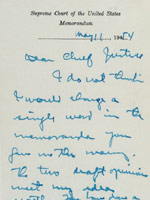
William Douglas to Earl
Warren, May 11, 1954.
Holograph letter.
Earl Warren Papers,
Manuscript Division (81A)
|
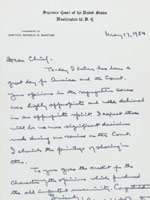
Harold H. Burton to Earl
Warren, May 17, 1954.
Holograph letter.
Earl Warren Papers,
Manuscript Division (82)
|
"A Great Day for America"
Associate Justice Harold H. Burton sent this note to Chief
Justice Earl Warren on the day that the Supreme Court's
decision in Brown v. Board was announced. He said, "Today
I believe has been a great day for America and the Court.
. . . I cherish the privilege of sharing in this." In a
tribute to Warren's judicial statesmanship, Burton added, "To
you goes the credit for the character of the opinions which
produced the all important unanimity. Congratulations."
|
Frankfurter's Congratulations to Warren
Associate Justice Felix Frankfurter, who had worked to
achieve a definitive repudiation of segregation by the
Supreme Court, sent this note to Chief Justice Warren on
the day that the decision in Brown v. Board was
publicly announced--a day that Frankfurter said would "live
in glory." Frankfurter added that the Court's role was
also distinguished by "the course of deliberation which
brought about the result."
|
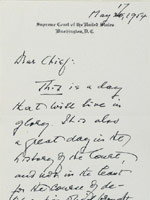
Felix Frankfurter to Earl
Warren, May 17, 1954.
Holograph letter.
Earl Warren Papers,
Manuscript Division (82B)
|

Waiting for courtroom seats,
1953.
Gelatin silver print.
New York World-Telegram & Sun Collection,
Prints and Photographs Division (74)
Digital ID# cph 3c13498
|
Waiting for Courtroom Seats
This photograph shows interested members of the public
waiting in line outside the Supreme Court for a chance
to obtain one of the 50 seats allotted to hear the second
round of arguments in the landmark Brown v. Board of
Education case. The case involved four states (Kansas,
Virginia, Delaware and South Carolina) and the District
of Columbia. Among an impressive array of legal representation
for the plaintiffs was Thurgood Marshall serving as chief
council for the NAACP. The opposing side was led by John
W. Davis, one time Democratic presidential candidate and
expert on constitutional law.
|
Warren's Reading Copy of the Brown Opinion,
1954
Chief Justice Earl Warren's reading copy
of Brown is annotated in his hand. Warren announced
the opinion in the names of each justice, an unprecedented
occurrence. The drama was heightened by the widespread prediction
that the Court would be divided on the issue. Warren reminded
himself to emphasize the decision's unanimity with a marginal
notation, "unanimously," which departed from the printed
reading copy to declare, "Therefore, we unanimously hold.
. . ." In his memoirs, Warren recalled the moment with genuine
warmth. "When the word 'unanimously' was spoken, a wave of
emotion swept the room; no words or intentional movement,
yet a distinct emotional manifestation that defies description." "Unanimously" was
not incorporated into the published version of the opinion,
and thus exists only in this manuscript. |
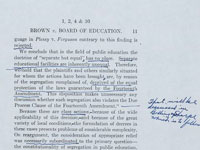
Earl Warren's reading copy
of Brown opinion,
May 17, 1954.
Earl Warren Papers,
Manuscript Division (83)
|
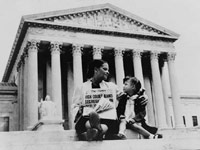
Mrs. Nettie Hunt and daughter
Nikie on the steps of the Supreme Court, 1954.
Gelatin silver print.
New York World-Telegram & Sun Collection,
Prints and Photographs Division (97)
Digital ID # cph 3c27042
|
Celebration of the Supreme Court's Decision
The Supreme Court's decision on the Brown v. Board of
Education case in 1954 marked a culmination in a plan
the NAACP had put into action more than forty years earlier--the
end to racial inequality. African American parents throughout
the country like Mrs. Hunt, shown here, explained to their
children why this was an important moment in history.

|
Segregation Ruling Explained to the Press
Chief counsel for the NAACP Thurgood
Marshall spoke to the press in New York City on May 31 after
the Supreme Court decreed an end to public school segregation
as soon as feasible. At the news conference in New York City,
Marshall told reporters ". . .the law had been made crystal
clear" and added, "Southerners are just as law abiding as
anyone else, once the law is made clear." He was speaking
after Brown II, the court's second opinion in the Brown case,
which ordered the implementation of the original ruling in
a "prompt and reasonable" start towards desegregation. |
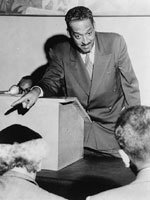
Thurgood Marshall explains
segregation
ruling to the press, 1955.
Gelatin silver print.
New York World-Telegram & Sun Collection,
Prints and Photographs Division (104)
|
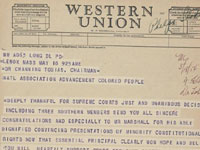
Anson Phelps Stokes to Channing
Tobias, Chairman of the NAACP, offering congratulations
on the NAACP's victory in Brown v. Board of Education.
Telegram.
NAACP Records,
Manuscript Division (96)
Courtesy of the NAACP
|
Congratulatory Telegram on Brown Decision
The NAACP's affiliation with the philanthropic
Stokes family began with J. G. Phelps Stokes, one of the
organization's founders. At the time of the Brown decision,
Anson Phelps Stokes was president of the Phelps-Stokes Fund,
a charitable trust that sponsored black schools and educational
projects. Stokes became familiar with the racial politics
of the South through his work with the Tuskegee Institute.
This telegram celebrates the consensus of the Southern justices
and urges the NAACP to "heartily support the court decision
postponing implementing orders so that these wonderful new[s]
gains may be safe guarded with minimum disturbances in a
difficult situation. . . ." |
Congratulatory Letter on the Brown Decision
William Patterson was an attorney and
former Executive Secretary of the International Labor Defense
(ILD), an organization dedicated to protecting the rights
of racial minorities, political radicals, and the working
class. In 1931, the ILD competed with the NAACP for the right
to represent the "Scottsboro Boys," nine black men convicted
of raping two white women. The NAACP lost the bid because
it lacked a full-time legal staff spurring Walter White,
then head of the NAACP, to hire Charles H. Houston and set
up a legal department. In this letter Patterson, head of
the Civil Rights Congress, a leftist organization, attributes
opposition to the Brown decision to "the demoralizing
effect of segregated schools on white youth. It has made
bigots out of millions who have not learned in their separate
schools that there are no superior people." |
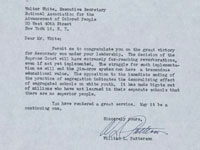
William L. Patterson, Executive
Secretary of the Civil Rights Congress, to Walter White
congratulating White on the NAACP's victory in Brown
v. Board of Education,
May 17, 1954.
Typed letter.
NAACP Records,
Manuscript Division (95)
Courtesy of the NAACP
|
The Library of Congress
does not have permission to show this image online
The Crisis magazine: A Record
of the Darker Races.
Volume 61, no. 6 (June-July, 1954).
General Collections (92) |
An African American Response
The multi-faceted African American response
to the decision was articulated throughout the black press
and in editorials published in official publications of national
black organizations. Founded in 1910, The Crisis magazine,
shown here, is the official organ of the National Association
for the Advancement of Colored People (NAACP). In response
to the decision, a special issue of The Crisis was
printed to include the complete text of the Supreme Court
decision, a history of the five school cases, excerpts from
the nation's press on segregation ruling, and the text of
the "Atlanta Declaration," the official NAACP response and
program of action for implementing the decision. |
Conferring at the Supreme Court
In 1929 Louis L. Redding, a graduate
of Brown University and Harvard Law School, became the first
African American attorney in Delaware--the only one for more
than twenty years. He devoted his practice to civil rights
law and served as the counsel for the NAACP Delaware branch.
In 1949 Redding won the landmark Parker case, which
resulted in the desegregation of the University of Delaware.
In1951, Redding and Greenberg tried two cases in Delaware's
Chancery Court: Bulah v. Gebhart and Belton
v. Gebhart, which respectively concerned elementary
school and high school. On April 1, 1952, Judge Collins Seitz
ordered the immediate admission of black students to Delaware's
white public schools, but the local state-run-school board
appealed the decision to the U.S. Supreme Court. |
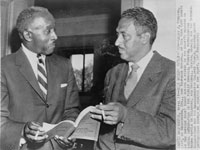
Louis L. Redding of Wilmington,
Delaware, and Thurgood Marshall, General Counsel for the
NAACP, conferring at the Supreme Court, during recess in
the Court's hearing on racial integration in public schools,
1955.
Gelatin silver print.
Visual Materials from the NAACP Records Photograph,
Prints and Photographs Division (111)
Courtesy of the NAACP
|
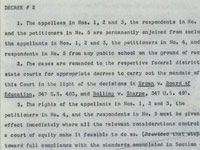
Felix Frankfurter's draft
decree in Brown II,
April 8, 1955.
Page 2
Typescript with emendations.
Felix Frankfurter Papers,
Manuscript Division (107)
|
Frankfurter's Draft Decree in Brown II, 1955
After the Brown opinion was announced, the Court
heard additional arguments during the following term on the
decree for implementing the ruling. In a draft, prepared
by Felix Frankfurter, which Warren subsequently adopted,
Frankfurter inserted "with all deliberate speed" in place
of "forthwith," which Thurgood Marshall had suggested to
achieve an accelerated desegregation timetable. Frankfurter
wanted to anchor the decree in an established doctrine, and
his endorsement of it sought to advance a consensus held
by the entire court. The justices thought that the decree
should provide for flexible enforcement, appeal to established
principles, and suggest some basic ground rules for judges
of the lower courts. When it became clear that opponents
of desegregation were using the doctrine to delay and avoid
compliance with Brown, the Court began to express
reservations about the phrase. |
Topeka School Map
In response to requests from two Justices
during the oral arguments of the implementation phase of Brown
v. Board, Kansas Attorney General Harold Fatzer provided
the Court with this map of the Topeka public school districts
along with 1956 enrollment estimates by race. Although almost
all of the schools shown were either overwhelmingly white
or completely black, Fatzer argued that Topeka had not deliberately
gerrymandered the districts so as to concentrate black pupils
into a few districts. Also shown is a key to the map, representing
the placement of students in the districts. |
The Library of Congress
does not have permission to show this image online
Raymond F. Tilzey.
The Elementary School District Boundaries for the City of Topeka 1955- 1956.
Printed Map.
Earl Warren Papers,
Manuscript Division (109) |
|
The Library of Congress does not have permission
to show this image online
Ralph McGill to Earl Warren, June 1, 1955.
Typed letter.
Earl Warren Papers,
Manuscript Division (113A) |
Southern White Liberal Reaction
Many white Southern liberals welcomed
the moderate and incremental approach of the Brown implementation
decree. Ralph McGill, the influential editor of the Atlanta
Constitution, wrote in praise of the Court's decision
to have local school boards, in conjunction with Southern
court judges, formulate and execute desegregation orders.
Certain that "the problem of desegregation had to be solved
at the local level," he told Chief Justice Warren that the
Court's ruling was "one of the great statesman-like decisions
of all time," exceeding all previous decisions "in wisdom
and clarity." |
Adverse Reactions to Brown
Challenges to legal and social institutions
implicit in the Brown decision led to adverse reactions
in both Northern and Southern states. U.S. Solicitor General
Simon Sobeloff forwarded to Chief Justice Warren this letter
from an official of the New York chapter of the Sons of the
American Revolution. The official attributed the impetus
behind the Court's action to "the worldwide Communist conspiracy" and
claimed that the NAACP had been financed by "a Communist
front." |
The Library of Congress
does not have permission to show this image online
Lee Hagood to Simon Sobeloff, September
29, 1955.
Typed letter.
Earl Warren Papers,
Manuscript Division (116A) |
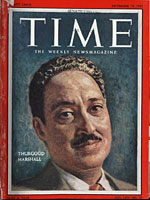
Time magazine,
September 19, 1955.
Cover.
General Collections (115)
Courtesy of Time-Life Pictures, Getty Images
|
Thurgood Marshall
After the U.S. Supreme Court's decision
on May 17, 1954, and May 31, 1955, desegregating schools,
Thurgood Marshall (1908-1994), was featured on the cover
of Time magazine, on September 19, 1955. Born in
Baltimore, Maryland, Marshall graduated with honors from
Lincoln University in Pennsylvania. His exclusion from the
University of Maryland's Law School due to racial discrimination,
marked a turning point in his life. As a result, he attended
the Howard University Law School, and graduated first in
his class in 1933. Early in his career he traveled throughout
the South and argued thirty-two cases before the Supreme
Court, winning twenty-nine. Charles H. Houston persuaded
him to leave private law practice and join the NAACP legal
staff in New York, where he remained from 1936 until 1961.
In 1939, Marshall became the first director of the NAACP
Legal Defense and Educational Fund, Inc. President Lyndon
B. Johnson appointed Marshall as Solicitor General in 1965
and nominated him to a seat on the United States Supreme
Court in 1967 from which he retired in 1991.

|
Barnard Elementary, Washington, D. C.
This image of an integrated classroom
in the previously all white Barnard Elementary School in
Washington, D.C., shows how the District's Board of Education
attempted to act quickly to carry out the Supreme Court decision
to integrate schools in the area. However, it did take longer
for the junior and senior high schools to integrate. |
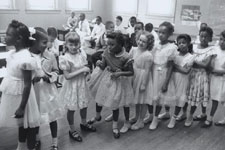
Thomas J. O'Halloran.
School integration, Barnard School, Washington,
D.C., 1955.
Gelatin silver print.
U.S. News & World Report Magazine Collection,
Prints and Photographs Division (202)
|
|

























